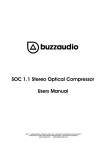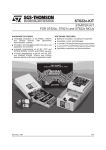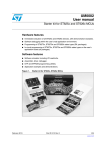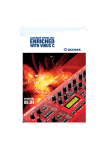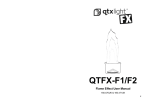Download Buzzaudio SOC-20 Specifications
Transcript
SOC-20 Stereo Optical Compressor Users Manual SOC-20 USERS MANUAL VERSION-1, AUGUST 2011. CONTENTS COPYRIGHT BUZZ AUDIO LTD 2011. PO BOX 6677, TE ARO. WELLINGTON, 6141 NEW ZEALAND. PH. +64-4-472-3084 www.buzzaudio.com email [email protected] Welcome… Thank you for choosing the Buzz Audio SOC-20 Stereo Optical Compressor. In this manual you will find important information regarding the use of the SOC and we suggest you do read it before using the unit to become familiar with all the controls and their function. If after unpacking the SOC you find any damage to the unit you should contact your dealer or supplier immediately for advice on what to do. We also suggest you retain the original packaging at least during the warranty period in case you need to return the unit for servicing, however we are confident this will not be necessary! Contents 1] Installation Precautions..........................................................3 2] The Mains Input.........................................................................3 3] Audio Connections...................................................................3 4] Controls and Indicators..........................................................4 5] Specifications ..............................................................................8 6] Service Information...................................................................8 7] Warranty Information ..............................................................9 8] Recall Sheet ..............................................................................10 ② 1] Installation Precautions The SOC-20 compressor uses discrete Class A amplifiers and these plus the power supply do generate a fair amount of heat. Normally the SOC can be mounted into a rack without any special ventilation need. If there are other units in the rack that also run hot, it may be necessary to allow for ventilation gaps between the units to avoid over heating. Excessive heat for long periods can shorten the life of all electronic devices. 2] The Mains Input The SOC-20 mains input can be set to run from 110V or 230V. On the rear panel you will find a circular voltage selector switch to set this. Generally the SOC mains voltage is set for the country to which it has been initially sent, but before powering up the unit, please check the voltage selector. POWERING UP THE SOC WITH THE WRONG VOLTAGE SETTING MAY CAUSE BURN OUT OF THE POWER TRANSFORMER! It is also important to fit the correct mains fuse. Below the IEC inlet you will see the fuse draw. Using a small flat blade screwdriver, you can flick open the draw and change the fuse if required. The fuse draw also has a place to hold a spare fuse (the square tube). The correct fuses are; 110V = 2 amp slow blow 230V = 1 amp slow blow These fuses will either be fitted in the fuse draw, and/or supplied in an accessory bag with the SOC. 3] Audio Connections On the rear panel of the SOC you will find the XLR input and output connectors. All these connectors are wired as follows; Pin 1 = Chassis Ground Pin 2 = Signal + (hot) Pin 3 = Signal – (cold) Note that the pin1 connection of these connectors is not part of the audio path, and is provided to shield the interconnecting cable. Leaving pin 1 free at one end of the cable can help reduce earth loops with other equipment as only the signal hot and signal cold are required. Generally speaking, keeping the signals balanced is a good idea, but all the inputs and outputs of the SOC-20 will accept unbalanced lines and signals if you have no other choice. ③ There are two audio paths provided, the LINE path and the S/C (side chain) path. The main audio input and output connect to the LINE connectors and if you wish to insert another device into the SOC-20 side chain (more on this later), use the S/C INSERT connectors. 4] Controls and Indicators The SOC-20 has two channels with identical controls. By now you might have guessed that the SOC-20 can be used as 2 mono audio compressors, a stereo compressor (left/right) and stereo mid/side compressor. In either case the controls of the two channels are the same. DRIVE This control adjusts the amount of signal sent to the side chain circuit and therefore the amount of gain reduction (or compression) applied to the input signal. Clockwise rotation increases the amount of gain reduction. OUTPUT dB Adjusts the post compression make up gain to bring the output level back up to the desired volume. Clockwise rotation increases gain from 0dB to +15dB gain. ATTACK This switch has 5 positions and adjusts the time taken (in milli-seconds) for the SOC to respond to signals that exceed the threshold (as set with the Drive control). This is the time taken to achieve 20dB of gain reduction. The “A” position is Auto where the attack time is totally dependant on the program material and the amount of gain reduction occurring. This is perhaps the most “musical” mode and could also be called the “Classic Sound” setting. RELEASE This switch sets the time taken (in 100’s of mS) for the SOC-20 to release from 20dB gain reduction. For example, selecting setting 4 means the compressor will take approx 400mS to return to 0dB gain reduction from an initial 20dB of gain reduction. “A” stands for Auto and in this position a clever little circuit is ④ engaged which allows the SOC to release from fast transient signals quickly, but maintain a slower release time with more continuous signals such as low frequencies or bass. RATIO This switch sets the amount of gain reduction (or compression) for a given change in input signal level. For example, in position 6, a 6dB increase in input signal level will yield a 1dB increase in output signal level, being a Ratio of 6:1. Because the SOC-20 has a soft knee characteristic, the Ratio value selected is the ultimate achieved after approx 10dB of gain reduction, so the Ratio will be softer with small amounts of gain reduction. This is the characteristic that makes the SOC sound so unique. BYPASS In the up position, this switch provides a hard relay bypass of audio input to audio output with no electronics in the signal path. This is useful in comparing the compressed to un-compressed signal. When using the SOC with stereo signals, both A and B channels’ bypass switches would be operated together for a meaningful result. I/P–G/R–O/P This switch is used to monitor signals on the VU meter. At I/P position the VU meter monitors the audio input signal as applied to the LINE input connector. At G/R position the meter displays the amount of gain reduction or compression applied to the audio input signal. Note that the meter provides an “indication” of the amount of gain reduction and does not accurately display fast transient attacks. At O/P position the VU meter monitors the LINE output signal post the Output gain make up control. The operation of the meter is unaffected by the Bypass switch. S/C HPF When this switch is down (IN) a 12dB per octave high pass filter at 170Hz is placed into the SOC side chain path. This has the affect of reducing compressor sensitivity at low frequencies and is useful when you wish to retain bass information but still compress higher frequencies. ⑤ S/C INSERT The SOC-20 is fitted with a side chain insert point. This allows you to place another device between the audio LINE input and the SOC side chain circuits. (If you are unfamiliar with the term “side chain” it is the circuit in a compressor which takes the audio signal and generates a suitable signal to control the gain reduction element, whatever that may be). A device can be connect to the S/C INSERT rear panel connectors and engaged by placing the S/C INSERT switch down (IN). If no device is connected, the compressor will stop working when switched to IN. You can also monitor the S/C INSERT RETURN signal by placing the S/C INSERT switch to the up (MON) position. Note that if nothing is connected to the insert return input, the monitor function will not work. To allow monitoring of the side chain in MS mode, use a patch cable to connect S/C Insert Send to the S/C Insert Return. Typical uses for the side chain insert point are inserting an equalizer so complex frequency dependant compression can be accomplished, for example, de-essing. Using the sound of an instrument to compress another instrument (often called keying) using the insert return as the key input. PK LED This red led will light when the internal operating level has reached +22dB peak level indicating a possible clipping situation. It monitors the input and output circuits of the SOC-20. LDR LED This led is driven by the SOC side chain control signal and is provided to give an indication of attack and release settings and how they are applied to the audio. It can be mesmerising to watch – you have been warned! SEPARATE-LINK A/B In SEPARATE mode, the SOC-20 operates as two completely individual mono channels. When switched to LINK A/B, the compressor side chains are linked to provide stereo tracking. This mode is used to prevent the stereo “image” shifting if a loud sound appears only in one channel of a stereo mix. For example, if this mode is not selected, a loud floor tom panned hard left in a mix may cause the output stereo image to move towards the right as more gain reduction occurs in the left channel than the right (when used in Stereo Mode of course). ⑥ Note that unlike some VCA based compressors, all controls remain operational in LINK A/B mode. You MUST still set up BOTH A and B channel’s controls usually with identical settings for stereo program (non MS mode), and perhaps then fine tuned by ear. MODE STEREO-MID/SIDE As mentioned earlier, the SOC-20 can be used as two mono compressors and a stereo mix (left/right) compressor. For these modes, this switch should be in the up position (STEREO). Note this is a locking toggle and you need to pull out the lever to operate it. When switched to MID/SIDE (switch down) the SOC-20 sum and difference amplifier circuits are engaged. These circuits take the stereo left/right input (as applied to the Channel A and B Line Input connectors) and generate a sum signal (audio that is common to left and right) and a difference signal (signals that are not common). These signals are referred to as MID and SIDE. The MID signal is fed into Channel A’s compressor and the SIDE signal to Channel B’s compressor, then back to another set of sum and difference amplifiers to regenerate the stereo signal. This allows you to compress the MID and SIDE signals separately and is an extremely powerful tool for processing stereo sounds. Note the MS mode will only work with stereo signals. You can monitor the generated MID and SIDE signals with the S/C MON function (use a patch cord between S/C INSERT SEND and RETURN connectors if no insert device is connected). The MID and SIDE signals pre-compression are outputted at the S/C INSERT SEND connectors. • Please Note! When switching the MODE switch, a large amount of reconfiguration takes place within the SOC20 audio circuits and this will cause an audible click. We could have fitted a plethora of coupling capacitors to reduce this click but this caused to much signal degradation. The locking toggle prevents accidental operation. POWER ON This switches the mains power to the SOC-20 on and off. A yellow led tells you when it’s on. The SOC bypass relays are engaged for a few seconds at power up. ⑦ 5] Specifications Maximum Input Level Line; +32dBu Maximum Output Level Line; +27dBu Maximum Input/Output Level S/C Insert; +22dBu Noise; -95dBu Stereo Mode; -90dBu M/S Mode (measured with no make up gain and A Weighted). Gain; variable 0dB to +15dB Operating Level; +4dBu = 0VU on meter Frequency Response; 3Hz to 120kHz measured with +10dB gain and no gain reduction. Harmonic Distortion no gain reduction; 0.08% @ 100Hz, 0.025% @ 1kHz, 0.02% @ 10kHz, 0.05% @ 100kHz Harmonic Distortion with 20dB gain reduction (Attack AUTO, Release 16); 0.1% @ 100Hz, 0.06% @ 1kHz, 0.04% @ 10kHz Harmonic Distortion with 20dB gain reduction (Attack AUTO, Release AUTO 2%@ 100Hz, Mains Voltage; 110-115Vac or 220-240Vac switchable. 6] Service Information We are confident that you will receive many years of trouble free operation from your unit. If however you experience any technical problem with your SOC-20, contact your dealer or Buzz Audio for recommendations on what to do. The SOC is constructed with non-surface mount serviceable parts, this means most electronic faults can be easily repaired. Please note there are no user serviceable parts inside the SOC-20 and attempting any internal adjustments without the alignment instructions and correct test equipment may render the unit un-operational. For on line support visit our web site www.buzzaudio.com Buzz Audio Ltd, PO Box 6677, Wellington 6141, New Zealand. Phone +64-(0)4-472-3084. Email; [email protected] ⑧ 7] Product Warranty • Disclaimer Buzz Audio Ltd is not liable for any damage to microphones, amplifiers, consoles, speakers or any other equipment and/or electric shock to humans that is caused by negligence or improper installation and/or use of the SOC-20 Stereo Optical Compressor. • Standard Product Warranty Buzz Audio Ltd guarantees the SOC-20 Stereo Optical Compressor to be free of defective materials and/or workmanship for a period of 1 year (12 months) from the date of sale, and will replace defective parts and repair malfunctioning products under this warranty when the defect occurs under normal installation and use – provided the unit is returned to our factory (or duly authorised service centre) via prepaid transportation with a copy of the proof of purchase, ie, sales receipt. This warranty provides that examination of the returned product must indicate, in our judgment, a manufacturing defect. This warranty does not extend to any product that has been subjected to misuse, neglect, accident, improper installation, or where the date code has been removed or defaced. The standard warranty is NOT transferable. • Product Warranty Extension The above Warranty may be extended to a period of 2 years (24 months) from date of sale provided the enclosed Warranty Registration card is completed and returned to the office of Buzz Audio Ltd within 4 weeks (28 days) from purchase date. Alternatively, you may Register your purchase on-line at our web-site www.buzzaudio.com. The Extended Warranty is transferable. SOC-20 USERS MANUAL VERSION-1, AUGUST 2011. CONTENTS COPYRIGHT BUZZ AUDIO LTD 2011. PO BOX 6677, TE ARO. WELLINGTON, 6141 NEW ZEALAND. PH. +64-4-472-3084 www.buzzaudio.com email [email protected] ⑨ ⑩










